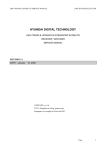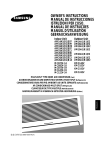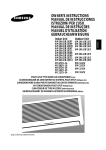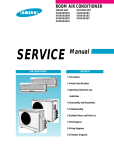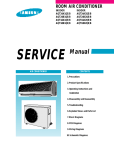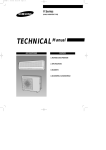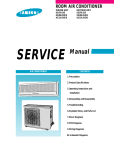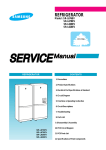Download Samsung AM26A1(B1)B13 Product specifications
Transcript
ROOM AIR CONDITIONER INDOOR UNIT AM24A1(B1)E12 AM26A1(B1)B13 SERVICE OUTDOOR UNIT UM24A1(B1)E2 UM26A1(B1)B2 Manual AIR CONDITIONER CONTENTS 1. Precautions 2. Product Specifications 3. Operating Instructions and Installation 4. Disassembly and Reassembly 5. Troubleshooting 6. Exploded Views and Parts List 7. Block Diagrams 8. PCB Diagrams 9. Wiring Diagrams 10. Schematic Diagrams 1. Precautions 1. Warning: Prior to repair, disconnect the power cord from the circuit breaker. 2. Use proper parts: Use only exact replacement parts. (Also, we recommend replacing parts rather than repairing them.) 3. Use the proper tools: Use the proper tools and test equipment, and know how to use them. Using defective tools or test equipment may cause problems later-intermittent contact, for example. Fig. 1-1 Avoid Dangerous Contact 4. Power Cord: Prior to repair, check the power cord and replace it if necessary. 5. Avoid using an extension cord, and avoid tapping into a power cord. This practice may result in malfunction or fire. 6. After completing repairs and reassembly, check the insulation resistance. Procedure: Prior to applying power, measure the resistance between the power cord and the ground terminal. The resistance must be greater than 30 megohms. Fig. 1-2 No Tapping and No Extension Cords 7. Make sure that the grounds are adequate. 8. Make sure that the installation conditions are satisfactory. Relocate the unit if necessary. 9. Keep children away from the unit while it is being repaired. 10. Be sure to clean the unit and its surrounding area. Fig. 1-3 No Kids Nearby! Fig. 1-4 Clean the Unit Samsung Electronics 1-1 2. Product Specifications 2-1 Table Model Item AM24A1(B1)E2 INDOOR UNIT OUTDOOR UNIT INDOOR UNIT OUTDOOR UNIT AM24A1(B1)E12 UM24A1(B1)E2 AM26A1(A1)B13 UM26A1(B1)B2 Type Wall-Mounting Multi Split Cooling Performance AM26A1(B1)B2 BTU/h 12,000 24,000(12,000x2) 12,000 24,000(12,000x2) Dehumiditying I/h 1.9 - 1.9 - Air volume Cooling 3 m /min 8.5 - 8.5 - dB 38 56 38 Noise Cooling Power ~ V-Hz 56 ~ 1-220-240V . 50Hz 1-220V 60Hz Power Consumption Cooling W 1,230 2,460(1,230x2) 1,360 2,720(1,360x2) Operating Current Cooling A 5.3 10.6(5.3x2) 6.3 12.6(6.3x2) Power factor Cooling % Power Starting current WxHxD Weight H05RNF(5G 1mm2) 3.15 - 3.15 - mm 815x298x182 1000x790x310 815x298x182 1000x790x310 inch 32.08x11.73x7.17 39.37x31.10x12.2 32.08x11.73x7.17 39.37x31.10x12.2 9.6 Liquid Gas H07RNF2.5 A kg Drain hose OD(mm)xL(m) 67 9.6 67 ø6.35x5 ø6.35x5 ø12.7x5 ø12.7x5 ID(mm)xL(m) ø17x2,000 Type - Rotary - Rotary Model name - 48A124JV1E5 - 48A135IV1E5 Capacitor - 30µF x 420VAC - 25µF x 450VAC - - - - - 1210 - 1210 Cross-fan Propeller Cross-fan Propeller Resin Still Resin Still 35 60 35 60 2Row 12Step 2Row 30Step 2Row 12Step 2Row 30Step Motor Type(model) Rated output W Type Blower - H05RNF(5G 1mm ) dimension pressor H07RNF2.5 2 Outer Com- 30 - Fuse capacity Size 98.1 A Power cord(Option) Refrigerant pipe 96.7 Motor Type Rated output W Heat exchanger Refrigerant control unit A,B-UNIT : Capillary Tube Freezer oil capacity cc - 410 - 410 Refrigerant to change(R-22) g - 830x2 - 800x2 Protection device - MRA12030-12008 - MRA12002-9200 Standard Conditions ISO R5151 Standard ARI Standard •The basic performance test is based on the piping of 5MT. (Be sure to check the installing conditions as extension of the piping may lead to performance degradetion.) Samsung Electronics 2-1 2-2 Dimensions 2-2-1 Indoor Unit (Remote control) (Front view) Air in 815 182 58 22 Air out Installation plate (Rear view) 2-2-1 Outdoor Unit (Front view) (Rear view) 660 1000 2-2 335 Samsung Electronics 2-3 Refrigerating Cycle Block Diagram INDOOR UNIT OUTDOOR UNIT T1 (A) (B) Capillary tube 2-way valve Liquid side Heat exchanger (Evaporator) Compressor-B Heat exchanger (Evaporator) T2 Gas side 3-way valve Cooling Gas leak check point Compressor-A Refrigerating cycle temperature and pressure Operating Condition A or B Cooling A+B Standard Max over load Low temp. Standard Max over load Low temp. Samsung Electronics STD Pressure (kg/cm2G) 3-way valve 5.0~5.2 6.0~6.3 3.4~3.6 5.0~5.2 6.0~6.3 3.4~3.6 Piping Temp.(˚C) T1 T2 11 16 3 12 16 3 11 15 2 10 15 2 DB 27 32 21 27 32 21 Temp. Condition(˚C) Indoor Outdoor WB DB WB 19 35 24 23 43 26 15 21 15 19 35 24 23 43 26 15 21 15 2-3 3. Operating Instructions and Installation 3-1 Operating Instructions 3-1-1 Name & Function of Key in remote controller NO FUNCTION OF KEY NAMED OF KEY On/Off Button. Use this button to start and stop air conditioner. 1 2 (UP) Temp. up button. If the button is pressed once, the setting temperature is increased by 1°C (DOWN) Temp. down button. If the button is pressed once, the setting temperature is decreased by 1°C Each time you press this button, MODE is changed in the following order. 3 MODE 4 TURBO Use this button to provide heavy duty cooling & Heating for 30 minutes. 5 OFF Set up the reserve or cancel the timer on and timer off quickly 6 Use this button for sleep operation. (The SLEEP mode can be selected at COOL and HEAT mode.) 7 Adjusts air flow vertically. Each time you press this button, Each time you press this button, FAN SPEED is changed in the following order. 8 9 10 11 12 13 C O V E R T I M E R ON TIMER Set up the time that operation start. OFF TIMER Set up the time that operation stop. SET Use this button to reserve the timer on. CANCEL Use this button to reserve or cancel the timer on and timer off. (UP) If the button is pressed once, the time increase by one minute during the time set mode, and ten minutes during the timer set mode. (DOWN) If the button is pressed once, the time decrease by one minute during the time set mode, and ten minutes during the timer set mode. 14 15 TIME Samsung Electronics Without regard to ON/OFF condition in remote controller, use this button to set current time. Adjust the current time using button. (Data can be transmitted after setting up the time) 3-1 Operating Instructions and Installation 3-1-2 Name & Function of Key in remote controller 1. AUTO MODE : In this mode, operation COOL mode is selected automatically by the room temperature of initial operation. Operation Type Cool Operation Room Temp Tr≥ 24.5°C+∆T Compressor ON Tr≤ 24°C+∆T Compressor OFF ∆T= -2°, -1°C, 0°C+1°C+2°C ∆T is controlled by setting temperature up/down key of remote controller * FAN SPEED : AUTO 2. COOL MODE : The unit operates according to the difference between the setting and room temperature. (18°C~30°C) 3. DRY MODE : Has 3 states, each determined by room temperature. The unit operates in DRY mode. *Compressor ON/OFF Time is controlled compulsorily(can not set up the fan speed, always breeze). *Protective function : Low temperature release. (Prevention against freeze) 3-2 4. TURBO MODE : This mode is available in AUTO, COOL, DRY, FAN MODE. When this button is pressed at first, the air conditioner is operated “powerful” state for 30 minutes regardless of the set temperature, room temperature. When this button is pressed again, or when the operating time is 30 minutes, turbo operation mode is canceled and returned to the previous mode. *But, if you press the TURBO button in DRY or FAN mode that is changed with AUTO mode automatically. 5. SLEEP MODE : Sleep mode is available only in COOL mode. The operation will stop after 6 hours. *In COOL mode : The setting temperature is automatically raised by 1°C each 1hour When the temperature has been raised by total of 2°C, that temperature is maintained. 6. FAN SPEED : Manual (3 step), Auto (4 step) Fan speed automatically varies depending on both the difference between setting and the room temperature. Samsung Electronics Operating Instructions and Installation 7. COMPULSORY OPERATION : For operating the air conditioner without the remote controller. *AUTO : The operating is the same function that AUTO MODE in the remote controller. 8. SWING : BLADE-H is rotated vertically by the stepping motor. 9. Quick OFF TIMER: OFF timer (quick timer) allows reservation or cancel the timer on and timer off quickly When OFF timer button is pressed at operating state, LCD displays the polling state sequentially. The LCD also displays the time remaining. OFF TIMER : The air Conditioner is turned OFF at a specified time using OFF TIMER . *ON TIMER : Only timer LED lights on. *OFF TIMER : Both timer and operation LED lights on. *3 minutes delay timer. 11. SELF Diagnosis LED DISPLAY 10. 24-Hour ON/OFF Real Setting Timer. : The air conditioner is turned ON at a specified time using ON TIMER . Samsung Electronics Check Point operation TIMER FAN Turbo Interruption of electric power and Power on. Abnormal condition of the room sensor. Abnormal condition of the indoor unit's heat exchanger sensor. Indoor unit fan motor lock. LED : blinking : LED off 12. BUZZER SOUND : Whenever the ON/OFF button is pressed or whenever change occurs to the condition which is set up or select, the compulsory operation mode, buzzer is sounded "beep" 3-3 3-2 Installation 3-2-1 Selecting Area for Installation Select an area for installation that is suitable to the customer's needs. 3. 3-2-1(a) Indoor Unit 1. Make sure that you install the indoor unit in an area providing good ventilation. It must not be blocked by an obstacle affecting the airflow near the air inlet and the air outlet. 2. Make sure that you install the indoor unit in an area allowing good air handling and endurance of vibration of the indoor unit. 3. Make sure that you install the indoor unit in an area where there is no source of heat or vapor nearby. 4. Make sure that you install the indoor unit in an area from which hot or cool air is spread evenly in a room. 5. Make sure that you install the indoor unit in an area away from TVs, audio units, cordless phones, fluorescent lighting fixtures and other electrical appliances (at least 1 meter). 6. Make sure that you install the indoor unit in an area which provides easy pipe connection with the outdoor unit, and easy drainage for condensed water. 7. Make sure that you install the indoor unit in an area which is large enough to accomodate the measurements shown in figure on the next page. 3-2-1(b) Outdoor Unit 1. Make sure that you install the outdoor unit in area not exposed to the rain or direct sun light. (Install a separate sunblind if exposed to direct sun light.) 2. Make sure that you install the outdoor unit in area allowing good air moment, not amplifying noise or vibration, especially to 4. 5. 6. 7. 8. avoid disturbing neighbours. (Fix the unit firmly if it is mounted in a high place.) Make sure that you install the outdoor unit in area providing good ventilation and which is not dusty. It must not be blocked by any obstacle affecting the airflow near the air inlet and the air outlet. Make sure that you install the outdoor unit in area free from animals or plants. Make sure that you install the outdoor unit in area not blocking the traffic. Make sure that you install the outdoor unit in area easy to drain condensed water from the indoor unit. Make sure that you install the outdoor unit in area which provides easy connection within the maximum allowable length of a coolant pipe (10 meters). Note 1. Add 10 grams of refrigerant (R-22) for every 1 meter if the pipe length exceeds the standard pipe length of 5 meters. 2. Maintain a height between the indoor and outdoor units of less than 3 meters. Make sure that you install the outdoor unit in an area which is large enough to accommodate the measurements shown in figure on the next page. 3-2-1(c) Remote Control Unit 1. Make sure that you install the remote control unit in an area free from obstacles such as curtains etc, which may block signals from the remote control unit. 2. Make sure that you install the remote control unit in an area not exposed to direct sunlight, and where there is no source of heat. 3. Make sure that you install the remote control unit in an area away from TVs, audio units, cordless phones, fluorescent lighting fixtures and other electrical appliances (at least 1 meter). Caution It is harmful to the air conditioner if it is used in the following environments: greasy areas (including areas near machines), salty areas such as coast areas, areas where sulfuric gas is present such as hot spring areas. Contact your dealer for advice. 3-4 Samsung Electronics Operating Instructions and Installation 3-2-2 Installation diagram of indoor unit and outdoor unit A Indoor unit gas leak test check point Indoor unit Piping may be laid to the rear, left, right or down . 3 Left Right 2 Rear Piping Down Rear Tape vinyl 1 B Drain hose installation Cut the piping hole sloped slightly Remote control Remote control holder 1 Piping (Liquid) 1/4" 6 Clamper tube 2 Piping (Gas) 1/2" 7 Installation plate 3 Installation tube 8 Pipe-connection 4 Vinyl tape 9 Screw 5 Putty 10 Drain hose Samsung Electronics 3-5 Operating Instructions and Installation 3-2-2(a) Fixing the Installation Plate 1. Determine the position of the pipe and drain hose hole using the right figure and drill the hole with an inner diameter of 65mm so that it slants slightly downwards. Installation plate Pipe hole (ø65mm) 2. If you are fixing the indoor unit to a… Then follow Steps… Wall 3. Window frame 4 to 6. 3. Fix the installation plate to the wall in a manner appropriate to the weight of the indoor unit. (Unit : mm) If you are mounting the plate on a concrete wall with anchor bolts, the anchor bolts must not project by more than 20mm. 280 (Unit : mm) 340 4. Determine the positions of the wooden uprights to be attached to the window frame. 5. Attach the wooden uprights to the window frame in a manner appropriate to the weight of the indoor unit. 6. Using tapped screws, attach the installation plate to the wooden uprights, as illustrated in the last figure opposite. 3-2-2(b) Purging the Unit On delivery, the indoor unit is loaded with an inert gas. All this gas must therefore be purged before connecting the assembly piping. To purge the inert gas, proceed as fol lows. Unscrew the caps at the end of each pipe. Result : All inert gas escapes from the indoor unit. • 3-6 To prevent dirt or foreign objects from getting into the pipes during installation, do NOT remove the caps completely until you are ready to connect the piping. Samsung Electronics Operating Instructions and Installation 3-2-2(c) Connecting the Assembly Cable. The outdoor unit is powered from the indoor unit via the assembly cable. If the outdoor unit is more than five metres away from the indoor unit, the cable must first be extended to a maximum of ten metres. 1. Extend the assembly cable if necessary. 2. Open the front grille by pulling on the tabs on the lower right and left sides of the indoor unit. 3. Remove the screw securing the connector cover. 4. Pass the assembly cable through the rear of the indoor unit and connect the assembly cable to terminals 1 to 5. • Each wire is labelled with the corresponding terminal number. 5. Pass the other end of the cable through the 65mm hole in the wall. 6. Replace the connector cover, carefully tightening the screw. 7. Close the front grille. 8. For further details on how to plug the other end of the assembly cable into the outdoor unit, refer to page 3-10. 3-2-2(d) Installing and Connecting the Indoor Unit Drain Hose Care must be taken when installing the drain hose for the indoor unit to ensure that any condensa tion water is correctly drained outside.l When passing the drain hose through the 65mm hole drilled in the wall, check that none of the following situations occur. The hose must NOT slope upw ards. The end of the drain hose must NOT be placed in water. Do NOT bend the hose in different directions. Keep a clearance of at least 5cm between the end of the hose and the ground. Do NOT place the end of the drain hose in a hollow. To install the drain hose, proceed as follows. 1. If necessary, connect the 2-metre extension to the drain hose. 2. If you are using the extension, insulate the inside part of the extension drain hose with a shield. 3. Pass the drain hose under the refrigerant piping, taking care to keep the drain hose tight. 4. Pass the drain hose through the hole in the wall, making sure that it is sloping downwards, as shown in the illustrations above. The hose will be fixed permanently into position once the whole installation has been tested for gas leaks; refer to page 16 for further details. Shield Drain hose Samsung Electronics Extension drain hose 3-7 Operating Instructions and Installation 3-2-2(e) Outdoor unit installation GAS LEAK TEST Outdoor unit check point Indoor unit check point Check for gas leak from the flare nut connections with leak detector. WIRING CONNECTION Two electric cables must be connected to the outdoor unit: • The assembly cable connecting the indoor unit to the outdoor unit. • The power cable connecting the auxiliary circuit breaker to the outdoor unit. 1 Remove the terminal board cover on the side of the outdoor unit. 2 Connect the assembly cable to terminals 1 to 5 and connect the power cable to therminals A to B. Each wire is labelled with the corresponding terminal number. Ensure that the wire number of the indoor unit and the terminal number of the outdoor unit. 3 Connect the earthing wires to the earth terminals. Refer to the page opposite for further details on how to check that earthing is correct. 4 Replace the terminal board cover, carefully tightening the screw. 5 connect the power cable to the auxiliary circuit breaker. Indoor unit Outdoor unit 4 3 2 FAN COMP (N) 4 1 3 (L) COMP FAN 1(L) 2(N) Terminal Block Earth terminal Circuit Breaker (Main Power cable) Earth terminal Earth terminal A-unit 3-8 B-unit Samsung Electronics Operating Instructions and Installation Grounding (The parts for this work are optional.) • A grounding terminal can be found on the outdoor unit as illustrated. 1. When an existing grounding terminal is avilable. (Grounding wire of ø1.6mm or larger<solid wire>or 2mm2 or larger <standard wire>) Terminal used exclusively for grounding. Grounding resistance: less than 100 ohms (existing grounding electrode) 2. Use of a grounding electrode. • Specifications of grounding electrode. Grounding screw hole Carbon plastic Steel core PVC-insulated wire(2mm2x3.5m), green Samsung Electronics Terminal, M4 3-9 Operating Instructions and Installation 3-2-2(f) Flare Modification • Tools used Flare modification procedure 1) Cut the pipe using a pipe cutter. 90° Oblique Raughness 2) Remove burrs at the tip of the pipe cut. Caution : Burrs not removed may result in leakage of gas. Burr Pipe Reamer 3) Insert a flare nut into the pipe and modifty flare. D A Outer diameter ø6.35mm ø9.52mm ø12.7mm A(mm) 1.3 1.8 2.0 * Unproper flaring Inclined 3-10 Surface damaged Cracked Uneven thickness Samsung Electronics Operating Instructions and Installation 3-2-2(g) Air Purging CAUTION The air in indoor unit and in the pipe must be purged. If air remains in the refrigeration pipes, it will affect the compressor, reduce to cooling/heating capacity, and could lead to a malfuction. Refrigerant for air purging is not charged in the outdoor unit. Use additional refrigerant as shown at the right figure. Each unit must be purged in turn 1. Check the piping connections 2. Connect the charging hose of low pressure side of Manifold gauge to the packed valve having a charging port(1/2” Packed valve) 3. Open the valve of the low pressure side of Manifold gauge counterclockwise for 10 seconds, and then close it to closed position. 4. Check for gas leakage. - Check the flare connections for gas leakage. INDOOR A-UNIT INDOOR B-UNIT 5. Purge the air from the system. - Loosen the liquid side(1/4”) flare nut after gas leakage check - Open the low pressure side valve of the Manifold gauge for 10 seconds to purge the air from the system. Repeat this three times or more. - Tighten the liquid side(1/4”) flare nut when the low pressure of the manifold gauge indicates about 0.5Kg/cm2. liquid side Gas side Pipeline 6. Set valve cork of both liquid side and gas side of packed valve to the open position. Flare Nut Valve cork Pipeline 7. Mount the valve stem nuts to the 2-way and 3-way valve. And mount the service port cap to 3-way valve Outdoor unit Charging Port 8. Check for gas leakage. - At this time, especially check for gas leakage from the 3-way valve’s stem nuts, and from the service port cap. Charging hose of Low pressure hose <Structure of 3-way valve> Samsung Electronics 3-11 Operating Instructions and Installation 3-2-2(h) Refrigerant Refill If connecting pipe of more than 10 metres is installed, additional refrigerant should be charged by extra metre. You don’t have to charge additional refrigerant up to 10 metres of connecting pipe. 1. Remove the valve stem cap and service port of 3-way valve. 2. Connect the charging hose of low pressure side of Manifold gauge to the packed valve having a charging port(1/2” Packed valve) as shown at the right figure. 3. Operate the unit at the cooling mode. 4. Slowly open the valve of the low pressure side of Manifold gauge counterclockwise until the low pressure of manifold gauge indicates 4.8 to 5.5 kg/cm2 at the high cool operation (1-unit operation) and the standard temperature.(for details, see the page 3-14) • Piping length and the height Pipe Size A-UNIT B-UNIT LIQUID 1/4” 1/4” GAS 1/2” 1/2” Additional refrigerant charge (R22,g) • When length of the pipe is over 5u by the unit, you should charge the refrigerant Formulas A-UNIT : 10gx(La-10)/m B-UNIT : 10gx(Lb-10)/m (La:the length of A-unit’s pipe Lb:the total length of B-unit’s pipe) Max.piping length A 15m 15m Max height B 3m 3m INDOOR UNIT A B OUTDOOR UNIT It is recommend that refrigerant should be slowly put in. If the refrigerant is put in too quickly, compressor will be damaged. 5. Stop operation of the air conditioner. 6. Disconnect the charge hose of manifold gauge. INDOOR A-UNIT INDOOR B-UNIT 7. Close the cap of each valve. 3-2-2(i) Flare unt fixing torque Outter diameter Torque (kg-cm) Fixing Torque Final Torque ø6.35(Liquid Side) 160 200 ø12.7(Gas Side) 500 550 3-12 Samsung Electronics Operating Instructions and Installation 3-2-2(j) Pump down 1. Confirm that both the 2-way and 3-way valves are set to the open position. (1) Remove the valve stem caps. (2) Be sure to use a hexagonal wrench to operate the Gas side valve stems. 2. Operate the unit for 10 to 15 minutes. 3. Stop operation and wait for 3 minutes, then connect the charge set to the service port of the 3-way valve. (1) Connect the charge hose with the push pin to the service port. 2-Way Valve 4. Air purging of the charge hose. (1) Open the low-pressure valve on the charge set slightly to air purge from the charge hose. Cap 5. Set the liquid side 2-way valve to the closed position. 3-Way Valve 6. Operate the air conditioner at the cooling cycle and stop operation immediately after setting the 3-way valve to the closed position when the gauge indicates 0 kg/cm 2G. If the unit can not be operated at the Cooling Mode(weather is rather cool), operate the unit at the Trubo Mode. So that the unit can be operated. 7. Disconnect the charge set, and mount the both 3way valve’s stem nuts and the service port cap. Relocation of the air conditioner • Refer to this procedure when the unit is relocated. 1. Carry out the pump down procedure (refer to the details of ‘pump down’). 2. Remove the power cord. 3. Disconnect the assembly cable from the indoor and outdoor units. 4. Remove the flare nut connecting the indoor unit and the pipe. At this time, cover the pipe of the indoor unit and the other pipe using a cap or vinyl plug to avoid foreign material entering. Samsung Electronics 5. Disconnect the pipe connected to the outdoor unit. At this time, cover the valve of the outdoor unit and the other pipe using a cap or vinyl plug to avoid foreign material entering. 6. Make sure you do not bend the connection pipes in the middle and store together with the cables. 7. Move the indoor and outdoor units to a new locatioon. 8. Remove the mounting plate for the indoor unit and move it to a new location. 3-13 Operating Instructions and Installation 3-2-3 Technical Document • Cooling Characteristics - Outdoor Temperature Indoor Unit(D/WB) : AM24A1(B1)E12 : 27/19, AM26A1(B1)B13 : 27/19.5 AM24A1(B1)E2 : 240V/50Hz, AM26A1(B1)B2 : 220V/60Hz Cooling Capacity & Air Outlet Temperature Cooling Capacity (AM24A1(B1)E12) Cooling Capacity (AM26A1(B1)B13) Air Outlet Temp. (AM24A1(B1)E12) Air Outlet Temp. (AM26A1(B1)B13) 15 15000 14 14000 13 13000 12 12000 11 10 11000 21/15(15.5) 21/19(19.5) 35/24 43/26(25.5) Outdoor Temperature(DB/WB) Current & Low Pressure Cooling Capacity (AM24A1(B1)E12) Cooling Capacity (AM26A1(B1)B13) Low Pressure (AM24A1(B1)E12) Low Pressure (AM26A1(B1)B13) 8 15000 7 14000 6 13000 5 12000 4 3 11000 21/15(15.5) 21/19(19.5) 35/24 43/26(25.5) Outdoor Temperature(DB/WB) 3-14 Samsung Electronics 4. Disassembly and Reassembly Stop operation of the air conditioner and remove the power cord before repairing the unit. 4-1 Indoor Unit No Parts 1 Front Grille Procedure Remark 1) Stop the air conditioner operation and block the main power. 2) Seperate the tape of front. Panel upper. 3) Contract the second finger to the left and right handle and pull to open the inlet grille. 4) Take the left and right filter out. 5) Loosen one of the right fixing screw and seperate the terminal cover. 6) Open the cover screw and loosen three fixing screws of front grille. 7) Pull the upper left and right of discharge softly for the outside cover to be pulled out. 8) Pull softly the lower part of discharge and push it up Caution: Assemble the front panel and fix the hooks of left and right. Samsung Electronics 4-1 Disassembly and Reassembly No Parts Procedure 2 Filter Frame 1) Loosen the left and right screw of the Holder Filter, and Separate the Holder Filter. 3 Ass'y Tray Drain 1) Do ①② , above. Separate the holder at the rear side of Indoor unit. Remark 2) Take the display PCB out. (Center of indoor unit). 3) Loosen three fixing screws of left and right. 4) Pull tray drain out from the back body. 4 Main PCB 1) Do " ①② ", above 2) Take all the connector of PCB upper side out. 3) Separate the outdoor unit connection wire from the terminal block. 4) If pulling the Main PCB up, it will be taken out. (Separate the TRANS hook, it before). 4-2 Samsung Electronics Disassembly and Reassembly No Parts 5 Heat Exchanger Procedure Remark 1) Do " ①②③④ ", above. 2) Loosen the left screws of the heat exchanger. Lifting the heat exchanger up a little to push the up side for separation from the indoor unit 6 Fan Motor and Cross Fan 1) Do " ①②③④⑤ ", above. 2) Loosen the fixing two screws and separate the motor holder. 3) Loosen the fixing screw of motor fan. (By use of M3 wrench) Separate the motor from the fan. Separate the fan motor the left holder bearing. Samsung Electronics 4-3 4-2 Outdoor Unit No Parts 1 Cabinet Procedure 1) 2) 3) 4) 5) 6) Remark Turn off the unit and remove the power cable Remove the top cover. Remove the control box cover. Unplug the ass'y cable. Remove the cabi-side. Remove the cabi-front. * When you assemble the parts, check if the each parts and electric connectors are fixed firmly. 2 4-4 Fan Motor & Propeller Fan 1) Do Procedure 1 above. 2) Remove the nut flange. (Turn to the right to remove as it is a left turned screw) 3) Disassemble the propeller fan. Samsung Electronics 5. Troubleshooting 5-1 Items to be checked first 1) Is the voltage of the power correct? The input voltage shall be rating Voltage ±10% range. The airconditioner may not operate properly if the voltage is out of this range. 2) Is the link cable linking the indoor unit and the outdoor unit linked properly? The indoor unit and the outdoor unit shall be linked by 5 cables. Check the terminals if the indoor unit and outdoor unit are properly linked by the same number of cables. Otherwise the airconditioner may not operate properly. 3) When a problem occurs due to the contents illustrated in the table below it is a symptom not related to the malfunction of the airconditioner. NO Operation of air conditioner Explanation 1 The COOL operation indication LED (Green) blinks when a power plug of the indoor unit is plugged in for the first time. It indicates power is on. The LED stops blinking if the operation ON/OFF button on the remote control unit is pushed. 2 In a COOL operation mode, the compressor does not operate at a room temperature higher than the setting temperature that the IN DOOR FAN should operate. In a HEAT operation mode, the compressor does not operate at a room temperature lower than the setting temperature that indoor fan should operate. In happens after a delay of 3 minutes when the compressor is reoperated. The same phenomenon occurs when a power is on. As a phenomenon that the compressor is reoperated after a delay of 3 minutes, the indoor fan is adjusted automatically with reference to a temperature of the air blew 3 Fan speed setting is not allowed in AUTO or DRY mode. The speed of the indoor fan is set to LL in DRY mode. Fan speed is 5 steps is selected automatically in AUTO mode. 4 Compressor stops operation intermittently in DRY mode. Compressor operation is controlled automatically in DRY depending on the room temperature and humidity. 5 Timer LED only of the indoor unit lights up and the air conditioner does not operate. Timer is being activated and the unit is in ready mode. The unit operates normally if the timer operation is cancelled. 6 The compressor stops intermittently in a COOL mode or DRY mode, and fan speed of the indoor unit decreases. The compressor stops intermittently or the fan speed of the indoor unit decreases to prevent inside/outside air frozen depending on the inside/outside air temperature. mode 4) Indoor unit observes operation condition of the air conditioner, and displays self diagnosis details on the display panel. NO Display Self Diagnosis 1 Operating LED blinking (1Hz) Restore from power failure (input initial power) 2 TIMER LED blinking (1Hz) Indoor unit Room sensor Error (open or short) 3 OPERATING and TIMER LED blinking (1Hz) Indoor unit heat exchanger temperature sensor Error (open or short) 4 FAN LED blinking (1Hz) Indoor fan malfunctioning (for speed is Below 38Orpm) Samsung Electronics 5-1 5-2 Fault Diagnosis by Symptom 5-2-1 No Power (completely dead)-Initial diagnosis 1) 2) Checklist : (1) Is input voltage normal? (2) Is AC power linked correctly? (3) Are connections between primary side, secondary side of the power transformer and PCB good. (4) Is output voltage of DC regulator IC KA7812 (IC01) normal? (11VDC-12.5VDC) (5) Is output voltage of DC regulator IC KA7805 (IC02) normal? (4.5VDC-5.5VDC) Troubleshooting procedure Remove power cord and plug in again in approx. 5 seconds Is operation lamp blinking? NO YES Replace PCB display Is DC voltage of PCB display normal? NO Is 198~264VAC applied to the primary side of the power transformer? NO YES Does operation start when run/stop button on the remote controller unit pushed? NO Is transmission display of the remote controller unit blinking? NO YES Are voltages of #62 (compressor), #60(4 way valve) and #61 (outdoor fan) of the micom normal? 5VDC Is voltage of #63 (indoor fan) of the micom normal? DC5V Is 14~18VAC appear in the secondary side of the power transformer? NO NO Normal Refer to remote control unit fault diagnosis YES Is "beep"sound heard from the main unit? YES Is DC voltage of the PCB module normal? •Check linkage between power cord and terminal tap •Check fuse YES Replace PCB module. NO Are voltages at RY71(Compressor) and SY72(outdoor fan) YES RY73(4-way valve) normal? DC12V Is voltage at SS71(indoor fan) 10ms YES YES NO Check connections compressor 4-way valve, outdoor fan and indoor fan. Is voltage at #32 terminal of the Micom normal? 0VDC Is voltage at #64 terminal of the Micom normal? 5VDC Replace power transformer Replace RY71, RY73, RY72 and SS71 NO YES Is output voltage of ICO2 normal? Is voltage at #25 terminal of the micom normal? 10ms YES NO NO Are voltage at #30 and #31 of the micom normal? NO YES Check PCB pattern. Replace main PCB. Replace ICO2 NO Is voltage output terminal of D101~D105(IN4007) normal? YES NO Replace resonator (X501) 100ns YES Is operation normal? YES NO OK Replace IN4007 Replace micom OK 5-2 Samsung Electronics Troubleshooting 5-2-2 When the Indoor Unit Fan Does Not Operate. (Initial Diagnosis) 1) Checklist : (1) Is the indoor unit fan motor properly connected with the connector (CN73)? (2) Is the AC voltage correct? (3) Is HALL IC in indoor fan motor properly connected with the connector (CN43)? (4) Is the running capacitor properly connected with the terminal? 2) Troubleshooting procedure After unplugging out the power cord should be reconnected within five seconds. YES NO Check as in the procedur “NO power parts” Refer tp page 5-2. Does the operating lamp(Green) blink? YES Does the Solid State Relay(SS71) work properly? Test rod location + - SS71- SS71- NO Microcomputer is out of order. Normal Voltage 12V YES Is the supply voltage of the fan motor sufficient? Test rod location PCB CN73 Condition Fan operate YES NO PCB is out of order. Normal voltage AC 180V MF-C is out of order Fan motor is out of order. Samsung Electronics PCB should be replaced. Replace MFC Fan motor should be replaced. 5-3 Troubleshooting 5-2-3 When the Outdoor Unit Does Not Operate. (Initial Diagnosis) 1) Checklist : (1) Is input voltage normal? (2) Is the set temperature of the remote control higher than room temperature in COOL mode? (3) Is the POWER IN connector (terminal-tab) linked correctly? (4) Is the outdoor unit properly connected with the TERMINAL BLOCK connector(5P)? 2) Troubleshooting procedure (1) Checking procedures for the indoor unit. After unplugging out the power cord should be reconnected within five seconds. NO Does the operating lamp blink Check as in the procedure "No Power parts" Refer to page 5-2. YES YES Room temperature sensor is out of order Does the timer lamp blink during operation ? NO PCB should be checked. 2 Is the power relay RY71 operated by adjusting the room temperature? Test rod location NO 1 Microcomputer is out of order. YES 3 Normal + - Condition Voltage IC1 Pin No.63 GND RY73 ON DC 4.8V IC1 Pin No.62 GND RY72 ON DC 4.8V PCB should be checked. NO 1) Is AC 198 - 264V applied relay between Terminal Tap(TB71) and RY 71 terminal No. 3 2) Is AC 198 - 264V applied relay between Terminal Tap(TB71) andCN 71 terminal No. 1 Power relay is out of order Power relay should be replaced. A Room operation YES “A”Compreessor or outdoor fan-motor replaced 1 NO 2 NO Is the room sensor normal register? 10°C 20°C 30°C 17.96k Ω 12.09k Ω 8.3k Ω YES 3 B Room or C Room operating Proceed to the checking points for the outdoor unit. 5-4 Samsung Electronics Troubleshooting 5-2-4 When the UP/DOWN Louver Moter Does Not Operate. (Initial Diagnosis) 1) 2) Checklist : (1) Is input voltage normal? (2) Is the UP/DOWN louver motor properly connected with the connector (CN61)? Troubleshooting procedure Remove power cord and plug in again in approx. 5 seconds. Y Is operating lamp blinking? Check as in the procedure "No Power parts". Refer to page 5-2. Y Does operation start when swing button of the remote control unit pushed? Y Normal N N Voltage at pin #33-#36 of micom (ICO4) change?(Squarewave) Micom (IC04) is faulty. Y N Volatge at pin #10, #11, #12, #13 of IC05 (KID65003) change?(Squarewave) Driver IC05 (KID65003) is faulty. Y UP/DOWN louver motor is faulty. 5-2-5 In the mode, When there is no warm air current. Check this first; (1) Is the set temperature of Remote Control lower than room temperature in Heat mode? (2) Is the Indoor PCB properly connected with the CN71 connector? After training on, the heating operation should star t in five minutes. YES Normal NO Is the munber #60 of Micom (IC04) DC 4.8 V? NO Abnormal Micom YES Is the munber #15 of IC07 (KID65003) LOW? NO Abnormal IC07 YES Is the voltage between CN71 #3Y71andNOR3 A C 1 9 8 ~ 2 6 4 ? NO Abnormal RY 7 3 YES Abnormal 4way valve of Outdoor Unit. or connecting Cable PCB should beeplaced. r 4 way valve should eplaced be r or connecting Cable Check. Samsung Electronics 5-5 Troubleshooting 5-2-6 If Operation By Remote Control Unit Is Impossible. (Initial Diagnosis) 1) Troubleshooting procedure Remove power cord and plug in again approx. 5 Seconds Is operation lamp blinking? N Y “ “ sound heard from the indoor unit when ON/OFF button on the remote control unit pushed? Y Check as in the procedure “NO Power parts”. Refer to page 5-2. Normal N Voltage of battery less than 2.5V (Remote Control Unit)? Y Replace battery. N LCD display status of REMOCON normal? N LCD is faulty. Y Transmission display lamp ( ) blinking when ON/OFF button on the remote control unit pushed? N Replace button. Y Voltage at PIN #30 of Remocon Micom change? N Micom is faulty. Y Voltage at collecter of Q601 or Q602 change? N Q601(C4375Y) or Q602(C1623Y) is faulty. IR LED(CL-1L5EU) is faulty. Y Voltage at pin #26 of micom (IC04) change (INDOOR UNIT)? N Receiver module is faulty. Y Micom (IC04) is faulty. 5-6 Samsung Electronics Troubleshooting 5-3 PCB Inspection 5-3-1 Cautions for Part Replacement 1. The human body carries much static electricity. Before touching a part for repair, replacement or the similar purpose, be sure to touch a grounded metallic portion by hand to let the static electricity go through the matallic portion to the earth. Espectially when handling any micro computer or IC, carefully remove such static electricity before touching them. 2. When repairing any part on a work bench, be sure to place an insulative sheet on the bench and always keep the sheet surface neat without any metal fragments. If any such fragment touches a part, a secondary trouble will possibly be caused in the part. 3. Before replacing any parts, be sure to turn off the power supply. If such replacement is done with the power supply kept on, an electric shock, short circuit or destruction of a part may result. 4. During replacement or repair of a part, carefully handle it : The printed circuit board has fine lead wires (jumper wires) and glass-made parts (diode) on its substrate. So if a circuit board is roughly handled, such lead wires and parts will be easily broken or damaged by bending or shock. 5. When soldering the lead wires of any new part, be sure to polish them using an emery paper or the like before solding them. Since the lead wires of any new part are covered with an oxide film, solder cannot adhere to the lead wires if not polished. 6. When soldering any part, care should be exercised not to apply any high-wattage soldering iron to the part for a long time. Some parts are of so low a heat resistance that they may be broken or have the properties changed if a soldering iron is so applied (Otherwise, the pattern may possibly be separated and raised). 7. The heat of the soldering iron should be transfered to the entire object to be soldered. If the solder pieces are not well fused due to insufficient transfer of the heat from the soldering iron, no satisfactory electrical continuity can be assured even if the soldered objects appear well connected to each other. 8. The solder used should be limited to a minimum. If excessive solder is used, it will cause inter-pattern contact, which may cause malfunction of the circuit. 5-3-2 Procedure The parts should be replaced in the following procedure. Check for any faulty part. Detach the faulty part. Replace it with a new part. Check the operation of the new part. The repair is completed. Samsung Electronics 5-7 Troubleshooting 5-3-3 Detailed Procedure No. Malfunction 1 Pull out the power plug from the AC terminal and confirm the fuse on the PCB assembly 1. Is the fuse blown? 2 Turn the power on. If lamp blinks trouble is not related to the items 1 through 4 on the right. Voltage check 3 4 5 5-8 Set operating mode when RMC switch pushed. Except for [FAN]mode and [TIMER] mode. Checking point (symptoms) Causes 1. Voltage over 2. Indoor unit fan motor short-circuit. 1. AC voltage at both end of transformer Primary? 198 - 264V~ 1. Irregular power code or power fuse, or poor wiring. 2. AC voltage at both end of transformer secondary? 14- 18Vac 2. Transformer is faulty. 3. DC voltage at OUT and GND of IC01 (KA7812)? 12VDC 3. Power circuit is faulty. 4. DC voltage at OUT and GND of IC02? 5VDC 4. Power circuit is faulty. 5. DC voltage at Q201 Base and GND change? squarewave 5. Q201 is faulty. D101~D104 (1N4007x4) Voltage check 1. Voltage of relay (RY71) coil Voltage at pin#12, pin#5 of IC07 : 12VDC 1. Relay(RY 71) coil is open. IC07 is faulty. 2. Voltage at Terminal Tap (TB71 or 72) and RY71 Terminal N0 3 . 198- 264V~ 2. Relay(RY 71) contactor is faulty. Set operating mode when RMC switch pushed. 1. COOL mode 2. Fan speed [AUTO] 3. Set temperature lower than room temperature 4. Continuously operation. 1. Compressor does not operate. 1. Temperature of Heat exchange is lower. Set operating mode when RMC switch pushed. 1. [FAN] mode 2. Fan speed [Hi] 3. Continuously operation 1. Voltage at 3 5 both ends of CN73 : above 180V~ 1. Indoor unit fan motor is faulty. 2. Indoor unit fan motor does not operate. 2. Poor connection of indoor fan motor and connector of RPM sensing (CN43) 2. PCB is faulty. 3. Room sensor or Heat exchanger temperature sensor is faulty Samsung Electronics Troubleshooting 5-4 Fault Diagnosis of Major Parts Diagnosis Parts Temp.Sensor Heat ex. Sensor Indoor Fan Motor Measure resistance with a tester. Normal 8KΩ~27KΩ at ambient temperature (+0°C ~ +30°C) Abnormal ∞, O Ω … open or short Measure resistance between terminals (CN73) with a tester Normal At ambient temperature (10°C ~ 30°C) between Resistance Red, Yellow 190±10Ω Red, Blue 165±10Ω Abnormal Measure the voltage between ground and signal wire of the fan motor Normal Outdoor Fan Motor (UP/DOWN swing motor) Samsung Electronics Voltage Gray, Orange 05V~4.5V Yellow, Orange 5V Abnormal Abnormal if voltage does not change from 0V to 5V. Normal At ambient temperature (10°C ~ 30°C) Abnormal Stepping Motor between between Resistance Black, Yellow 189±10Ω Black, Red 190±10Ω ∞, O Ω … open or short Measure resistance between red wire and each terminal. Normal Approx. 380Ω at ambient temperature (20°C ~30°C) Abnormal ∞, O Ω … open or short 5-9 6. Exploded Views and Parts List 6-1 Indoor Unit 6-1 Samsung Electronics Exploded Views and Parts List ■ Parts List Q’TY No. CODE NO Description Specification 1 DB64-10140A GRILLE AIR INLET ABS 1 1 1-1 DB64-70073A PANEL CENTER DISPLAY PC 1 1 2 DB63-30131A GUARD AIR FILTER PP 2 2 3 DB74-10091A ASS´Y FILTER CLEANER/CARBON (1) (1) OPTION DB74-10091B ASS´Y FILTER CLEANER/CARBON (1) (1) OPTION 4 DB63-10472B COVER TERMINAL HIPS 1 1 5 DB92-70075E ASS´Y FRONT PANEL ASS´Y 1 1 6 DB93-10560B ASS´Y PCB DISPLAY ASS´Y(A1-GRILLE) 1(A1) 1(A1) DB93-10561B ASS´Y PCB DISPLAY ASS’Y(B1 GRILLE) 1(B1) 1(B1) 7 DB94-10088A ASS´Y TRAY DRAIN ASS´Y 1 1 7-1 DB95-20138A ASS´Y STEP MOTOR U/D DC12V.600GR 1 1 7-2 DB66-30153A BLADE-H HIPS 1 1 8 DB75-40077A ASS´Y EVAP ASS´Y 1 1 9 DB67-30058C SPACER EVAP PVC 1 1 10 DB61-00011B HOLDER MOTOR ASS´Y ASS´Y 1 1 10-1 DB65-00007A ASS´Y TERMINAL BLOCK ASS´Y 1 1 11 DB31-10078H MOTOR FAN IN AMPFS040WTVB 1 1 12 DB94-30141A ASS´Y-C-F-FAN Ø95 X 619.4mm 1 1 13 DB94-40017A ASS´Y BEARING ASS´Y 1 1 14 DB93-10595A ASS´Y MAIN PCB ASS´Y 1 - ! DB93-10584A ASS´Y MAIN PCB ASS´Y - 1 ! 15 DB32-10008D THERMISTOR ASS´Y ASS´Y 1 1 17 DB61-10151A CASE-CONTROL ABS(94-5V) 1 1 18 DB61-60093A BODY-BUSH HIPS 1 1 19 DB94-20030D ASS´Y BACK BODY ASS´Y 1 1 20 DB61-40247A HOLDER PIPE HIPS 1 1 21 DB70-10618A PLATE HANGER SGCC-M 1 1 Samsung Electronics AM24A1(B1)E12 AM26A1(B1)B09 Remark ! ! ! 6-2 6-2 Outdoor Unit 10-3 6-3 Samsung Electronics Exploded Views and Parts List ■ Parts List No. CODE NO Description Specification 1 1-1 2 3 DB90-10163D DB72-50520A DB67-50067A DB31-10141A DB95-20137J DB61-20094A DB90-10574A DB72-60053A DB90-40120A DB63-10433A DB63-10434A DB90-20207A DB99-10082A DB99-10148A DB62-40101A DB62-40099A DB62-31576A DB62-31883A DB63-30027C DB93-00028A DB93-40783A DB61-10199A DB65-10015A DB65-60008A 2501-001062 2501-000344 DB65-40072B 2501-000398 2501-001069 DB94-50041A DB72-60099A DB67-30083A DB90-10616A DB95-10062Y DB95-10062W DB73-10004A DB60-30028A DB60-30018A DB63-10165B DB47-20001Z DB47-20001G DB96-30080A DB63-30110J ASS'Y-WELD FRONT INSUL FRONT OUT FAN-PROPELLER MOTOR-FAN OUT MOTOR-FAN OUT BASE-MOTOR ASS’Y-CABINET-SIDE INSUL SIDE CABI ASS'Y COVER VALVE COVER-CONTROL COVER-VALVE ASS'Y-BASE OUT ASS'Y-VALVE ASS'Y-VALVE VALVE-PACKED 1/2" VALVE-PACKED 1/4" TUBE CAPI (C) TUBE CAPI (C) GUARD-COND ASS'Y CONTROL OUT ASS'Y CONTROL OUT CASE CONTROL OUT CLIP-CAPACITOR CLIP-CAPACITOR C-OIL C-OIL TERMINAL BLOCK C-OIL C-OIL ASS’Y-PARTITION INSUL PARTITION PARTITION ASS’Y CABI UPPER ASS'Y-COMP ASS'Y-COMP GROMMET-ISOLATOR NUT-HEXAGON NUT-FLANGE COVER-TERMINAL OLP OLP CONDENSER SCREEN-GUARD SC-90073T Foam pu + Foam pE AS+G/F20% OSME-606SRC AMASS-130ZTEC SGCC-M SECC-P FOAM PU + FOAM PE ASS'Y p.p P.P ASM240UE UM24A1(B1)E2 UM26A1(B1)B2 1/2” 1/4” ID 1.7 x 1000 ID 1.7 x 750 SC-90073T UM24A1E2 UM26A1B2 SGCC-M SGCC-M SGCC-M 30µF x 420V 25µF x 450V 8P 4µF x 450V 3.5µF x 450V SGCC-P FOAM PU + FOAM PE SGCC-M ASS’Y 48A124JV1E5 48A1351V1E5 EPDM M8 P10.8 NORYL MRA12030-12008 MRA12002-9200 ASS'Y P.E.H 100% 4 5 5-1 6 6-1 6-2 7 8 8-1 8-2 8-3 9 10 10-1 10-2 10-3 10-4 10-5 11 11-1 11-2 12 13 13-1 13-2 13-3 13-4 13-5 14 15 Samsung Electronics Q’TY UM24A1(B1)E2 UM26A1(B1)B2 1 1 1 1 1 1 1 1 1 1 1 1 2 2 2 1 1 1 2 2 1 1 1 1 1 1 2 6 6 2 2 2 1 1 1 1 1 1 1 1 1 1 1 1 1 1 2 2 2 1 1 1 2 2 1 1 1 1 1 1 2 6 6 2 2 2 1 1 Remark ! ! ! ! ! ! ! 6-4 6-3 Remote Control & PCB Box 6-3-1 Remote Control ■ Parts List No CODE NO Description 1 2 3 4 5 6 7 8 9 10 11 12 13 14 15 16 17 DB93-30071F DB61-10144A DB61-10145A DB64-20054A DB63-10477A DB74-10084A DB73-20110B DB64-40167A DB64-40166B DB68-10775A DB68-10777A PH-M2 DB67-60061A DB67-60062A DB67-60063A 90 250 DB93-40179B DB61-40243A ASS’Y CODE CASE UP CASE LOW DOOR REMOCON COVER BATTERY FILTER REMOCON RUBBER REMOCON INLAY LCD INLAY REMOCON LABEL REMOCON LABEL DOOR SCREW TAP SPRING BATTERY SPRING BATTERY SPRING BATTERY PE BAG ASS’Y PCB REMOCON HOLDER REMOCON 6-5 Specification Q’TY ABS ABS ABS ABS PC SILICON PC PC ART 90 ART 90 PH-M2 SUS 304 SUS 304 SUS 304 90 250 1 1 1 1 1 1 1 1 1 1 6 1 1 1 1 1 1 ABS Remark Samsung Electronics Exploded Views and Parts List 6-3-2 PCB Box 2-5 2-6 2-4 2-2 2-1 2-3 3 2 1 ■ Parts List CODE NO 1 DB61-10151A CASE-CONTROL ABS(94-5V) 1 1 2 DB93-10584A ASS'Y MAIN PCB ASS’Y - 1 DB93-10595A ASS'Y MAIN PCB ASS’Y 1 - 2-1 DB09-10149A IC - MCU MB89635R-466 1 1 2-2 DB32-10008D THERMISTOR ASS'Y 103AT 1 1 2-3 DE26-20154A TRANS-POWER AC230V DC17V 300mA 1 1 2-4 2306-000294 C-FILM CFS 99N 450VAC 155K 1 1 2-5 3501-001058 POWER-RELAY DI1U DC12V 1 1 2-6 DE32-10037A FUSE 250V 3.15A 1 1 3 DB93-10560B ASS'Y PCB DISPLAY A1-GRILLE 1(A1) 1(A1) DB93-10561B ASS’Y PCB DISPLAY B1-GRILLE 1(B1) 1(B1) Samsung Electronics Description Specification Q’TY Remark AM24A1(B1)E12 AM26A1(B1)B13 No 6-6 7. Block Diagrams 7-1 Micro Computer Block Diagram HEAT EXCHANGER SENSOR INDOOR CONTROL PANEL •BLADE-H CONTROL ROOM TEMPERATURE SENSOR •INDOOR FAN MOTOR CONTROL INFRARED SIGNAL RESET CIRCUIT •COMPRESSOR CONTROL INDOOR FAN MOTOR SPEED DETECT ZERO CROSSING •TEMPERATURE CONTROL OSCILLATION CIRCUIT REMOTE CONTROLLER •TIMER •BUZZER CONTROL MODE SELECT SWITCH TRIGER SIGNAL POWER ON/OFF MODE (AUTO, COOL, DRY, FAN) TURBO FAN SPEED SELECT • COMPRESSOR CONTROL SIGNAL • STEPPING MOTOR CONTROL SIGNAL • BUZZER CONTROL SIGNAL • COMPRESSOR DRIVE BLADE-H • STEPPING MOTOR DRIVE MOVING SELECT • BUZZER DRIVE DC 5V ON, OFF TIMER SELECT SSR INDICATOR PANNEL OPERATING/DEICE LED TIMER LED FAN ONLY LED TURBO LED INDOOR FAN MOTOR COMPRESSOR STEPPING MOTOR BUZZER DC 12V VOLTAGE REGULATOR TEMPERATURE SELECT SLEEP SELECT TIME SETTING AC INPUT Samsung Electronics POWER TRANSFORMER 7-1 8. PCB Diagrams 8-1 Main PCB 8-1 Samsung Electronics PCB Diagrams ■ PART LIST No DESIGN LOCATION CODE NO Description Specification Q’TY 1 F701 DE32-10037A FUSE FST 250V 3.15A 1 2 F701 DE47-40024A HOLDER-FUSE FH-51H 7.5A 1 3 IC01 DE13-20008A IC-VOLT REGU KA7812A 1 4 IC01 DE62-30032A HEAT-SINK AL H25 1 5 IC01 DE60-10100A SCREW-PH M3*6 FeFzY 1 6 IC02 DE13-10016A IC-VOLT REGU KA7805A 1 7 CR71 2306-000294 8 FT71 C-FILM CQS 450V 1.5 1 FILTER NOISE LSA05230P 1 1 9 R903 2001-000776 R-CARBON RD 1/2 T(S) 471-J 10 R203 2001-000588 R-CARBON RD 1/4 TP 332-J 1 11 R202,301,409,501~509,513,601,604,606,901 2001-000065 R-CARBON RD 1/4 TP 103-J 17 2 12 R405,407 2001-000036 R-CARBON RD 1/4 TP 331-J 13 R201,204,401,402,404,603,605 2001-000042 R-CARBON RD 1/4 TP 102-J 7 14 R607 2001-000855 R-CARBON RD 1/4 TP 560-J 1 15 R602 2001-001088 R-CARBON RD 1/2 T(S) 102-J 1 16 R403 2001-000890 R-CARBON RD 1/4 TP 682-J 1 17 R910,912 A1000-0244 R-CARBON RD 1/8 TP 332-J 2 18 R406,408 2004-001137 R-METAL FILM RD 1/4 TP 682-F 2 19 D101~105 0402-000137 DIODE-RECT 1N4007 5 20 SS71 B4190-0016 THYRISTOR G3MB-202PL 1 21 BZ61 DE30-20016A BUZZER CBE 2220BA STICK 1 22 TN71 DE26-20154A TRANS L.V 230V DC17V 300mA 1 23 TN71 DE60-60012A PIN EYELET OD2.5 L3.0 5 24 C202,402 2202-000783 C-CERAMIC CA OA 50V 103Z 2 25 C301,401 2202-000796 C-CERAMIC CA OA 50V 102Z 2 26 C102,104,201,203,403,404,501,502,901 2202-000780 C-CERAMIC CA OA 50V 104Z 9 27 C103 2401-000710 C-ELEC CE04 25V 222-M 1 28 C105 2401-001397 C-ELEC CE 04 25V 471-M 1 29 C101 2401-000180 C-ELEC CE 04 35V 102-M 1 30 C601 2401-001573 C-ELEC 47UF/50V 1 31 IC04 DE09-10149A IC-MCU MB89635R-466 1 32 IC03 DE13-20009A IC KA7533Z 1 33 X501 2802-000103 RSONATOR-CERAMIC 10MHz 1 34 IC05,IC06,IC07 DE13-20024A IC-DRIVE KID65003AP(KA2657) 3 35 Q201,401,601,602 A4050-0168 TR-GENERAL KSC945Y 4 1 36 Q603 0501-000292 TRANSISTOR A708Y 37 Q902, Q901 0504-000144 TRANSISTOR R2002 2 38 SW91 3404-001013 SWITCH-TACT KPT-1115V 1 39 CN73 3711-000262 CONNECTOR WAFER YW396-05AV WHT 1 40 CN43 3711-000879 CONNECTOR WAFER SMW250-03 BLU 1 41 CN41 3711-000940 CONNECTOR WAFER SMW250-04(WHT) 1 42 CN61 3711-000999 CONNECTOR WAFER SMW250-05 WHT 1 1 43 CN92 3711-001154 CONNECTOR WAFER SMW250-09 WHT 44 TB71 DE59-30001A CONNECTOR-TERMINAL 250TAP, 1PIN 1 45 RY71 3501-001058 RELAY DI1U DC12V 1 46 J1~J29,HR01,03,LR01 DE39-60001A WIRE SO COPER PI0.6 SN T 52MM 32 47 C701 C-MYLAR 224K 1 48 C702 C-MYLAR 104K 1 3 49 R904~906 50 CM71 51 RY72 Samsung Electronics 3501-000399 R-CARBON RD 1/2T(S) 621-J CONNECTOR WAFER YW396-03AV(BLK) 1 RELAY JQ1a-12V 1 8-2 8-2 ASS’Y DISPLAY & Module PCB 8-2-1 AM24A1E12/AM26A1B09 • DB93-10560B ■ PART LIST No Description CODE-NO 1 PCB-DISPLAY DB41-10204B FR-1 T1.6 W20 L170 1 2 LED - LAMP 0601-001333 LTL-30EHJ(ORG/GRN) 1 3 LED - LAMP 0601-001059 SY5511(YEL) 1 4 LED - LAMP 0601-001060 SM5511(GRN) 1 5 LED - LAMP 0601-001196 SO5511(ORG) 1 6 MODULE REMOCON DB32-50027A PNA4612MOOXD 1 7 C-CERAMIC 2202-000780 CA 0A 50V 104Z 2 8 R-CARBON 2001-000515 RD 1/8TP 221-J 2 9 CONNECTOR WAFER YWL A200-09P 1 10 C-CERAMIC 2001-000283 CA 0A 50V 102Z 1 11 DIOD SWITCHING 0401-000005 1N4148 1 12 C/W DIS & MODULE DB39-20346A UL1007 AWG#26/9 1 13 CASE-CENTER PCB UP DB61-10191A PC, BLUE 1 14 CASE-CENTER PCB LOW DB63-10494A ABS, BLK 1 15 SEAL DISPLAY UPP DB72-10233A FOAM-PE, BLK 1 16 SEAL CASE DISPLAY DB72-10220F 30FOAM-PE 1 8-3 Specification Q’TY Samsung Electronics PCB Diagrams 8-2-2 AM24B1E12/AM26B1B09 • DB93-10561B ■ PART LIST No Description CODE-NO 1 PCB-DISPLAY DB41-10205B FR-1 T1.6 W20 L170 1 2 LED - LAMP 0601-001333 LTL-30EHJ(ORG/GRN) 1 3 LED - LAMP 0601-001059 SY5511(YEL) 1 4 LED - LAMP 0601-001060 SM5511(GRN) 1 5 LED - LAMP 0601-001196 SO5511(ORG) 1 6 MODULE REMOCON DB32-50027A PNA4612MOOXD 1 7 C-CERAMIC 2202-000780 CA 0A 50V 104Z 2 8 R-CARBON 2001-000515 RD 1/8TP 221-J 2 9 CONNECTOR WAFER YWL A200-09P 1 10 C-CERAMIC 2201-000283 CA 0A 50V 102Z 1 11 DIOD SWITCHING 0401-000005 1N4148 1 12 C/W DIS & MODULE DB39-20346A UL1007 AWG#26/9 1 13 CASE-CENTER PCB UP DB61-10197A PC, BLUE 1 14 CASE-CENTER PCB LOW DB63-10494A ABS, BLK 1 15 SEAL DISPLAY UPP DB72-10245A FOAM-PE, BLK 1 16 SEAL CASE DISPLAY DB72-10220F 30FOAM-PE 1 Samsung Electronics Specification Q’TY 8-4 9. Wiring Diagrams 9-1 Indoor Unit 9-2 Outdoor Unit 1 2 3 4 ENGLISH BLK RED WHT YEL ESPANOL FRANCAIS ITALIANO NEGRO NOIR NERO ROJO ROUGE ROSSO BLANCO BLANC BIANCO AMARILLO JAUNE GIALLO UM24A1(B1)E2 CAPACITOR FAN MOTOR : 4µF/450VAC COMP MOTOR : 30µF/420VAC UM26A1(B1)B2 CAPACITOR 9-1 FAN MOTOR : 3.5µF/450VAC COMP MOTOR : 25µF/450VAC Samsung Electronics UPDA TE LOG SHEET Application date Page Part# Note(Cause & Solution) S/Bulletin# Use this page to keep any special servicing information. (Service Bulletin, etc.) If only parts number changes, Just change parts number directly on parts list. And if you need more information, please see the service bulletin Copyright Trademarks ®œ 1995 by Samsung Electronics Co., Ltd. All rights reserved. This manual may not, in whole or in part, be copied, photocopied, reproduced, translated, or converted to any electronic or machine readable from without prior written permission of Samsung Electronics Co., Ltd. Samsung is a registered trademark and SyncMaster 17GLi/CMG7387L and MacMaster Cable Adapter are trademark of Samsung Electronics Co., Ltd. SyncMaster 17GLi/CMG7387L Service Manual First edition June 1995. All other trademarks are the property of their respective owners. Macintosh, Centris, Quadra, Duo Dock, and Power Macintosh are trademark of Apple computer, Inc. 10. Schematic Diagrams 10-1 Indoor Unit BLK(L) SKY-BLUE BROWN BLACK PNA4612MøøXD 220 1/8W Samsung Electronics 10-1 10-2 Remote Control 10-2 Samsung Electronics















































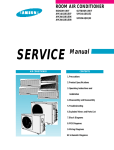
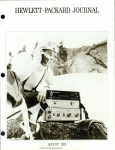
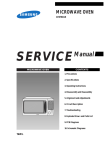
![[SPT-3000] e](http://vs1.manualzilla.com/store/data/005667089_1-a5f3766b3193f6552f250995926a69c5-150x150.png)
